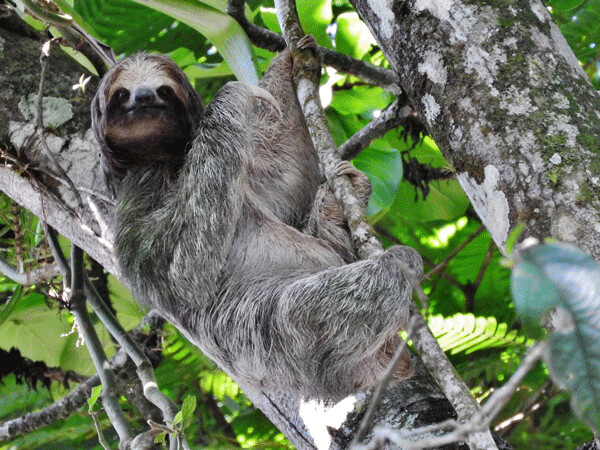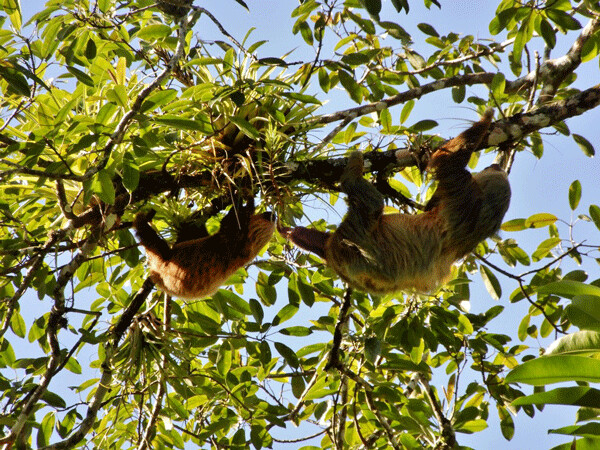A Slow Moving Symbiosis


On our first morning in Costa Rica, my group of 14 Museum members on the Natural Connections in Costa Rica trip rode through San Jose, over hills, and past volcanoes. Soon we left the Central Valley and headed for the Caribbean coast on our way toward breakfast. When—at last—the gates opened and we pulled into El Ceibo restaurant near Guapiles, Jimmy (our local guide) conferred with the gate operator briefly, then turned to us with the news: “There’s a sloth in the tree across the road!”
Naturally, we all piled off the bus with binoculars and cameras in hand. The two-toed sloth was just a fuzzy brown ball. Both two-toed and three-toed sloths live in Costa Rica. They all have three toes—but they have different numbers of fingers. Some scientists have started calling them by the more accurate name, “two-fingered sloth,” but to me that just sounds like a whiskey drink.
After everyone took a turn looking through Jimmy’s spotting scope, we headed inside for a breakfast buffet of beans, eggs, salsa, sausage, fried plantains, fresh fruit, and more coffee. It was a very different meal than what the sloth was eating. The sloth would also have to chew its purely leafy entrée twice: first on the way in, and again after the meal was fermented in a foregut.
Two- and three-toed sloths are both members of the elite club of arboreal (tree-dwelling) herbivores (solely eating plants), but they aren’t closely related. According to a 2014 article about sloths in the Proceedings of the Royal Society, by University of Wisconsin-Madison professor Jon Pauli, “only 10 species of mammals are considered specialized arboreal herbivores.” That’s just 0.2% of ALL mammal species! There’s a reason that cows don’t climb trees. The large stomachs required to digest their grassy diet are better suited to firm ground. Squirrels, on the other hand, focus on energy-dense nuts and seeds, and therefore don’t need a big gut to fuel their frenetic metabolism.
All of the world’s arboreal herbivores (including sloths, koalas and some monkeys and lemurs), have converged on a few common traits. First, they all weigh between 2 and 31 pounds. This size range reflects the tension between being small enough to climb, while still having a big enough stomach to digest tough plants. Their adaptations include ruminant-like digestive organs, slow metabolisms, and unusual behaviors.
For instance, sloths have taken a page from the reptiles’ book, and they sunbathe to help regulate body temperature. They also sleep a lot. Wild sloths sleep around 10 hours per day. Sloths in captivity give the others a bad name by sleeping up to 20 hours per day. I felt lucky, then, when we wandered outside after breakfast and caught a glimpse of a different two-toed sloth climbing across a branch with her baby. Two-toed sloths eat a somewhat more varied diet, and move greater distances.
On the other side of the parking area, a single three-toed sloth blended perfectly with a lichen-covered tree trunk. It was moving just fast enough for us to get a feel for their characteristically graceful and deliberate movements. Also, its permanent “Mona Lisa smile” was adorable. (Watch a video on my blog!)
While at first glance sloths may not appear to be the epitome of adaptation, they are actually an amazing, (slowly) moving hub of symbiotic partnerships, which Jon Pauli—from Wisconsin!—helped elucidate. It all begins when the sloth climbs down for its weekly bowel movement (sloths have the slowest known digestion rate of any mammal). During this trip to the soil, the sloth picks up fungal spores from a species that lives on its fur and helps ward off parasites. In addition, moths emerge from the sloth’s fur and lay eggs in the sloth’s droppings. The moth larvae feed off the dung, and then fly back up to the sloth after metamorphosis. This tight relationship seems to be part of the reason that three-toed sloths stick to living in just a few neighboring trees.
The adult moths seem to feed on secretions from the sloth’s skin, as well as algae on the sloth’s fur. Moth droppings act as a fertilizer, while grooves on the sloth’s fur create a little hydroponic irrigation system for the algae. Neither the algae nor the moth species occur anywhere but on a sloth (or on its dung).
While Pauli hasn’t yet calculated exactly how much energy sloths obtain from eating algae off their own fur as the groom, he has determined that the algae is a better source of fats than the tree leaves in the sloths’ diet. Keep in mind: a three-toed sloth only burns about 110 calories per day. The value of the moths and algae must be significant, because climbing down to defecate costs the sloth 8% of its daily energy budget, and puts it at high risk of predation.
We were happy to simply watch the sloths as they went about their slow business of living. Just looking at their thick fur coats made me uncomfortable as the temperature rose; but their languid movements were a good reminder of what it means to relax on a tropical vacation.
Emily’s book, Natural Connections: Exploring Northwoods Nature through Science and Your Senses is here! Order your copy at http://cablemuseum.org/natural-connections-book/. Listen to the podcast at www.cablemusum.org!
For 50 years, the Cable Natural History Museum has served to connect you to the Northwoods. Come visit us in Cable, WI! Our new exhibit: “Better Together
